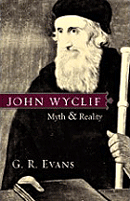Over the past five years no fewer than five new full-length books and two collections of essays have been published on John Wyclif himself, not his followers. (I keep having to revise this post after finding more!) Note that I have not seen all of these volumes (yet), so some comments here are from dust jackets and what other information I can find. My point here instead is to note the proliferation of interest. The several decades before 2000 only saw, at most, about one book per decade on Wyclif (at least, until one arrives back at the Wyclif Society and the hagiographical, protestant ecstasies surrounding his quincentenary in the late 1800s). Curtis Bostick’s Antichrist and the Lollards was published 1998, and before that Kenny’s two slim volumes appeared in the mid-1980s.

The first to note is a new biography, Gillian R. Evans’s John Wyclif: Myth and Reality (IVP Academic, 2006). Evans has published and edited many books on medieval theology and history, including A Brief History of Heresy in 2002. This is the first book-length biography to have been published since Kenny’s in 1985 (and before, that Workman’s 2-volume work in 1926). Evans apparently draws on much of her knowledge to draw an engaging picture of the intellectual and social environments of later-14th century Oxford.
The next volume might be called “introductory”: Ian Levy’s A Companion to John Wyclif (Brill, 2006). This (the one of these books I have read) includes a set of very helpful, well-written essays that introduce different key aspects of Wyclif’s thought (his logic, trinitarian and christological theology, political thought, sacramental theology, the Christian life, and the Bible); there is also a biographical essay, a list of his Latin writings, and an essay on his opponents.
The next four volumes are each more focused on Wyclif’s thought. The earliest, also by Levy, is entitled Scriptural Logic, Real Presence, and the Parameters of Orthodoxy (Marquette UP, 2003). Levy is concerned–here and in his translation of the de Veritate Sacrae Scripturae (Kalamazoo, 2001), work he completed along the way–with Wyclif’s realist philosophy and the status of Biblical text.
Another volume published by Stephen Lahey in the same year, Philosophy and Politics in the Thought of John Wyclif (Cambridge, 2003) is now (as of Dec. 2008) in paperback. Lahey focuses especially on Wyclif’s theories of dominion (which is what got him into trouble with the authorities at least as much as his sacramental theology) and the ways in which they impacted his arguments over politics. Lahey and Levy, along with Alessandro Conti, are this generation’s most prolific scholars on Wyclif’s thought.
Complementing Lahey’s volume is a new book by Elemér Boreczky entitled John Wyclif’s Discourse on Dominion in Community (Brill, 2008). Brill is, of course, an intensely academic publisher, but the dust jacket for this book seems to promise something like a praise poem, so I’ll be interested in comments which people might have on it’s content: “This book reconstructs Wyclif’s discourse on the theological and political consequences of his radically new insight into the integrity of man and nature as regards the good, free and beautiful life, communicated to his contemporary scholastic and lay audience. His theological, legal and political vision of the opportunity to restore original justice through the spiritual reality and sanctity of persona humana in every man as well as in the community by the law of love and the use and enjoyment of dominion in community enfolds through abundant quotes from his works, justifying his fame at the time of the birth of the modern nation as the King of Philosophers and the Fifth Evangelist.”

Lahey’s new book (Dec. 2008), entitled simply John Wyclif, is one of the fairly new “Great Medieval Thinkers” series published by Oxford. Not really a biography, this presents a contextualized overview of Wyclif’s thought. As Lahey describes, “This work draws on recent scholarship situating Wyclif in his fourteenth-century milieu to present a survey of his thought and writings as a coherent theological position arising from Oxford’s ‘Golden Age’ of theology. Lahey argues that many of Wyclif’s best known critiques of the fourteenth-century Church arise from his philosophical commitment to an Augustinian realism evocative of the thought of Robert Grosseteste and Anselm of Canterbury. This realism is comprehensible in terms of Wyclif’s sustained focus on semantics and the properties of terms and propositions, a ‘linguistic turn’ characterizing post-Ockham philosophical theology. Arising from this propositional realism is a strong emphasis on the place of Scripture in both formal and applied theology, which was the starting point for many of Wyclif’s quarrels with the ecclesiastical status quo in late fourteenth-century England.” In an Appendix Lahey translates a copy of Wyclif’s Confessio, a text which exists elsewhere only fragmentarily.
The last volume, Anne Hudson’s Studies in the Transmission of Wyclif’s Writings (Ashgate, 2008), moves away from direct consideration of his writings to present work on manuscript contexts. While most of the essays in this volume have been published before, four (an Introduction on the dissemination of Wyclif’s works, “Hussite catalogue of Wyclif’s Works,” “Wyclif Texts in fifteenth-century London,” and “The survival of Wyclif’s works in England and Bohemia”) are new contributions, enough to make a short volume by themselves.
Full references to all of these texts can be found in our Bibliography of Secondary Sources. Comments are open for this post in case anyone would like to follow up with more information.